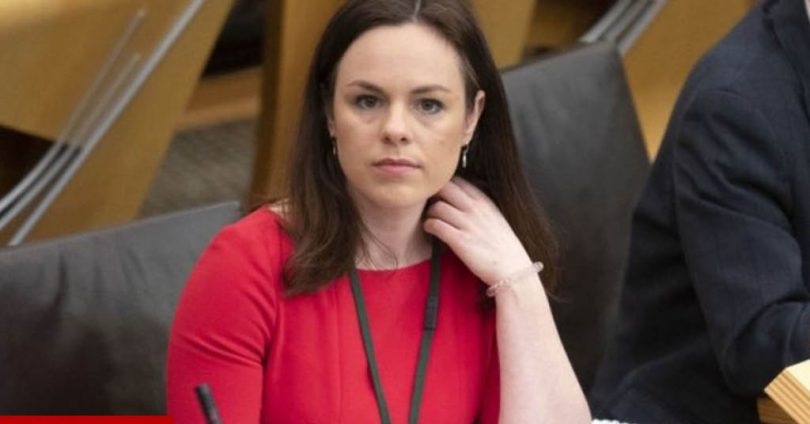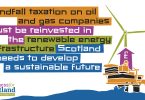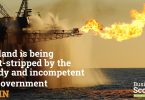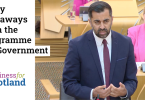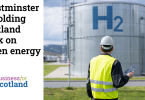Scottish finance secretary Kate Forbes this afternoon unveiled a Scottish ‘’Budget of choices’’ with three main aims: to tackle the climate emergency, support economic recovery and reduce inequalities.
Ms Forbes said the Budget came at a crucial time for Scotland and delivers on key commitments made in the Bute House Agreement with the Scottish Greens.
Measured included in the Scottish Budget included:
ECONOMIC RECOVERY FROM COVID
The economy is expected to recover to pre-pandemic levels by next summer according to the Scottish Fiscal Commission (SFC), which provides independent analysis of the Scottish economy. This is almost two years earlier than was previously forecast in January.
The SFC calculates the long-term economic damage of the Covid pandemic will be about minus 2% and expects unemployment to peak at 4.9% at the end of this year – also much lower than previous estimates.
The finance secretary said that the UK government’s spending review hindered rather than helped her on her mission
Ms Forbes said the Budget supports Scotland at a ‘’point of transition’’, balancing the response to Covid and the cost of living crisis. She said it would help people, businesses and services get back on their feet but the Scottish government could not deliver on these ambitions alone and so will harness a collaborative approach across all areas of Scottish life – public and private, national and local.
The finance secretary said that the UK government’s spending review hindered rather than helped her on her mission. With Covid funding removed, day-to-day funding next year is “significantly less” at a time when investment was needed in the economy and help public services recover.
Labour shortages, rising costs and inflationary pressures are to be tackled by investing in skills and employability and making “catalytic investments” to boost regeneration.
A national strategy for economic transformation is to be published.
HELP FOR BUSINESS
100% rates relief for retail, hospitality and leisure businesses will continue until nest April. It will then be set at 50% for the first three months of the next financial year, 2022-2023. Ms Forbes said this will “prevent a cliff edge” for businesses in those sectors, saving them a further £56m next year.
The finance secretary said that her 100% rates relief during the pandemic has saved businesses in Scotland around £1.6bn through the rates system alone since 1 April 2020.
Non-domestic rates will be 49.8p in the pound, “delivering a below inflation uplift for the fourth year in a row”.
Small businesses with a rateable value of less than £15,000 on Scottish high streets, will continue to pay no rates for all of next year, irrespective of what sector they are in, through the Small Business Bonus Scheme.
New builds will pay no rates for the first 12 months after occupation, through the Business Growth Accelerator. This is “directly seeking to revitalise our high streets”.
TAX
SCOTLAND’S income tax rates will remain the same through the next financial year. Starter and basic rates of income tax thresholds will increase in line with inflation (3.1%) , while higher and top rate thresholds will remain frozen at current levels.
Ms Forbes said this means most Scots will pay less than the rest in the UK and those who earn more will pay more.
Last year’s council tax freeze will end, with local authorities in Scotland being given “complete flexibility” to raise council tax rates as much as they wish.
Land and buildings transaction tax will remain the same.
COMBATING CLIMATE CHANGE
The budget sets out almost £2bn of low-carbon capital investment in infrastructure – decarbonising homes, buildings, transport and industry.
£1.4bn will be spent to “maintain, improve and decarbonise” Scotland’s rail network
This includes the first £20m of the 10-year Just Transition Fund, to help the north east and Moray transition from carbon based industries. Other initiatives are:
- A total of £336m has been allocated for energy efficiency and renewable heating
- Walking, wheeling and cycling will be promoted with £150m investment
- Large-scale decarbonisation projects have been allocated £60m and there will be £43m spent on promoting a circular economy
- £1.4bn will be spent to “maintain, improve and decarbonise” Scotland’s rail network
- Woodland creation gets £69.5m, increasing the target by 15,000 hectares, while £53m will be spent restoring the natural environment.
HEALTH AND SOCIAL CARE
The Budget includes a record funding of £18bn for health and social care, including £12.9bn for health boards. The money included:
- £1.2bn for mental health;
- Investment to support the recruitment of at least 3,500 teachers and 500 classroom assistants over this parliament;
- £200m to tackle the poverty-related attainment gap;
- £4bn spread across social security and welfare;
- £110m to fund free bus travel for young people from January;
- £72m to expand free school lunches for all P1-5 pupils;
- £544m for free funded early learning and childcare;
- £831m for affordable housing;
The budget’s key anti-poverty measure was the already announced doubling of the Scottish Child Payment to £20 a week, from April 2022.
Now that the Scottish Greens have joined the SNP in government, the draft budget is virtually certain to pass. The finance secretary may still meet with other parties for the sake of appearances but with the seven Green MSPs locked in, the plans announced on Thursday will not need to be revised.

